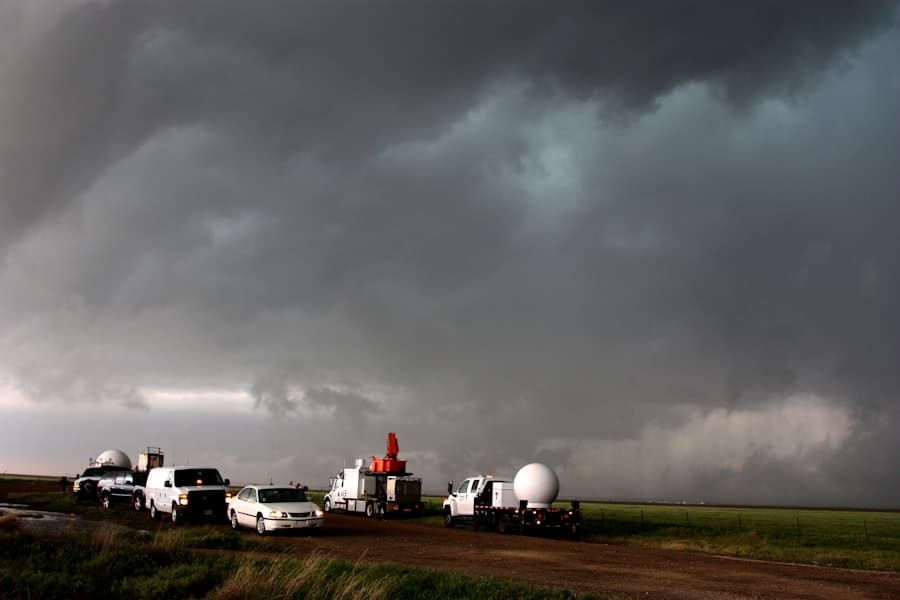Augmented Reality (AR) has emerged as a transformative technology, reshaping how we interact with digital content in our physical environments. By overlaying digital information onto the real world, AR creates immersive experiences that blend the virtual and the tangible. One of the most compelling advancements in AR is its integration with real-time weather changes.
This integration not only enhances the realism of virtual environments but also allows for dynamic gameplay that responds to actual weather conditions. As players navigate through these augmented landscapes, they encounter challenges and scenarios that mirror the unpredictability of nature, making the gaming experience more engaging and lifelike. The convergence of AR and real-time weather data opens up a plethora of possibilities for game developers.
By harnessing live meteorological information, games can adapt their environments, challenges, and narratives based on current weather conditions. For instance, a game set in a city might feature rain-soaked streets and reduced visibility during a downpour, while sunny weather could lead to vibrant colors and bustling activity. This level of detail not only captivates players but also encourages them to interact with their surroundings in novel ways, fostering a deeper connection between the game and the real world.
Key Takeaways
- Real-time weather changes can significantly impact the gameplay experience in augmented reality (AR) games.
- AR technology utilizes real-time weather data to create dynamic and immersive gaming experiences.
- Games like Pokémon Go and Harry Potter: Wizards Unite integrate real-time weather changes to enhance gameplay.
- Real-time weather changes play a crucial role in enhancing immersion and creating a more realistic gaming environment.
- While there are challenges and limitations in integrating real-time weather changes, the potential for future innovations in AR and real-time weather integration in gaming is promising.
The Impact of Real-Time Weather Changes on Gameplay Experience
The Unpredictability of Weather
For instance, in a racing game, players might find themselves navigating slick roads during a rainstorm, requiring them to adjust their driving techniques to maintain control. Similarly, in survival games, players may need to seek shelter from sudden storms or adapt their resource management strategies based on temperature fluctuations.
Enhancing Excitement and Engagement
This dynamic environment challenges players to think critically and react swiftly, enhancing the overall excitement and engagement of the game. Moreover, the impact of weather on gameplay extends beyond mere mechanics; it also affects the emotional tone of the experience. A sunny day can evoke feelings of joy and adventure, while a thunderstorm might create tension and urgency.
Emotional Resonance and Immersive Storytelling
This emotional resonance is amplified when players can see and feel the effects of weather changes in real time. For instance, a player exploring a fantasy world might feel a sense of dread as dark clouds roll in, signaling an impending storm that could unleash powerful enemies or environmental hazards. By integrating real-time weather changes, developers can craft narratives that are not only visually stunning but also emotionally compelling.
How AR Technology Utilizes Real-Time Weather Data
AR technology leverages real-time weather data through various methods, including APIs that provide live updates on meteorological conditions. These APIs can deliver information such as temperature, precipitation levels, wind speed, and atmospheric pressure directly to the game engine. By incorporating this data, developers can create environments that reflect current weather conditions accurately.
For instance, if a player is exploring an AR-enhanced city during a snowstorm, the game can simulate falling snowflakes, icy surfaces, and reduced visibility, all based on actual weather reports. Additionally, AR systems can utilize geolocation features to tailor experiences to specific regions. This means that players in different parts of the world can experience unique weather-related challenges that correspond to their local climate.
For example, a player in a tropical region might encounter heavy rainfall and thunderstorms, while someone in a desert area could face extreme heat and sandstorms. This geographic customization not only enhances realism but also encourages players to explore their environments more thoroughly, as they may discover unique gameplay elements tied to their local weather patterns.
Examples of Games that Integrate Real-Time Weather Changes
Several games have successfully integrated real-time weather changes into their gameplay mechanics, showcasing the potential of this technology. One notable example is “Pokémon GO,” which utilizes real-time weather data to influence the types of Pokémon that appear in different conditions. For instance, rainy weather increases the likelihood of encountering water-type Pokémon, while sunny days may boost grass-type spawns.
This integration encourages players to venture outside and explore their surroundings based on current weather conditions, fostering a sense of community as players share their experiences. Another example is “The Elder Scrolls: Blades,” which incorporates dynamic weather effects that change based on real-time data. Players can experience different environmental conditions as they progress through quests and battles.
The game’s ability to reflect actual weather patterns enhances immersion and adds an extra layer of challenge as players must adapt their strategies accordingly. These examples illustrate how real-time weather integration can create engaging gameplay experiences that resonate with players on multiple levels.
The Role of Real-Time Weather Changes in Enhancing Immersion
The incorporation of real-time weather changes plays a crucial role in enhancing immersion within AR gaming experiences. When players see their surroundings transformed by rain or snow, it creates a sense of authenticity that draws them deeper into the game world.
Players are not merely observing a digital landscape; they are actively participating in an environment that reacts to external factors.
For instance, experiencing a sudden downpour while exploring an AR landscape can create feelings of urgency and excitement.
Players may find themselves racing against time to complete objectives before adverse weather conditions hinder their progress. This emotional connection fosters a more profound investment in the game, as players become attuned to both the virtual narrative and their real-world environment.
Challenges and Limitations of Integrating Real-Time Weather Changes
Despite the exciting possibilities presented by integrating real-time weather changes into AR gaming, several challenges and limitations must be addressed. One significant hurdle is the reliance on accurate and timely weather data. Inaccurate forecasts or delays in data transmission can lead to discrepancies between the game’s environment and actual conditions, potentially frustrating players who expect a seamless experience.
Developers must ensure robust systems are in place to gather and process this data efficiently. Another challenge lies in balancing gameplay mechanics with realistic weather effects. While dynamic weather can enhance immersion, it can also introduce complexities that may detract from the overall experience if not implemented thoughtfully.
For example, excessive rain might obscure visibility to the point where gameplay becomes frustrating rather than enjoyable. Developers must carefully calibrate these effects to maintain an engaging experience while still reflecting real-world conditions.
Future Possibilities and Innovations in AR and Real-Time Weather Integration
The future of AR integration with real-time weather changes holds immense potential for innovation and creativity within the gaming industry. As technology continues to advance, we may see even more sophisticated systems capable of simulating complex weather patterns with greater accuracy. For instance, future games could incorporate predictive modeling to anticipate upcoming weather changes based on historical data and current trends, allowing for even more dynamic gameplay experiences.
Moreover, advancements in machine learning and artificial intelligence could enable games to adapt not only to current weather conditions but also to player behavior and preferences. Imagine an AR game that learns how players respond to different weather scenarios over time and adjusts challenges accordingly. This level of personalization could create uniquely tailored experiences that resonate deeply with individual players.
The Potential of Real-Time Weather Integration in Gaming
The integration of real-time weather changes into AR gaming represents a significant leap forward in creating immersive and engaging experiences for players. By blending digital content with actual environmental conditions, developers can craft dynamic worlds that respond to both player actions and real-world factors. As technology continues to evolve, the possibilities for innovation in this space are boundless, promising exciting new adventures for gamers around the globe.
The potential for real-time weather integration not only enhances gameplay but also fosters a deeper connection between players and their environments, paving the way for a new era of interactive entertainment.
If you’re interested in how technology is enhancing our daily lives, you may want to check out this review of smartwatches by Huawei. These devices offer a wide range of features that can help you stay connected and organized on the go. Just like how AR is integrating real-time weather changes into gameplay, smartwatches are revolutionizing the way we interact with technology in our everyday lives.
FAQs
What is AR integration in gameplay?
AR integration in gameplay refers to the use of augmented reality technology to overlay digital elements onto the real world, creating an immersive and interactive gaming experience.
How does AR integrate real-time weather changes into gameplay?
AR can integrate real-time weather changes into gameplay by using location-based data to reflect the current weather conditions in the game environment. For example, if it is raining in the real world, the game may show rain in the virtual world as well.
What are the benefits of integrating real-time weather changes into gameplay?
Integrating real-time weather changes into gameplay can enhance the realism and immersion of the gaming experience. It can also add an element of unpredictability and challenge to the gameplay, as players may need to adapt to changing weather conditions.
What are some examples of games that integrate real-time weather changes using AR?
Some examples of games that integrate real-time weather changes using AR include Pokémon Go, which adjusts the appearance and behavior of certain Pokémon based on the weather, and The Weather Channel app, which uses AR to show real-time weather effects in the user’s surroundings.
What technology is used to enable AR integration of real-time weather changes into gameplay?
AR integration of real-time weather changes into gameplay typically relies on a combination of GPS data, weather APIs, and AR software development kits (SDKs) to accurately track the player’s location and reflect real-world weather conditions in the game environment.



